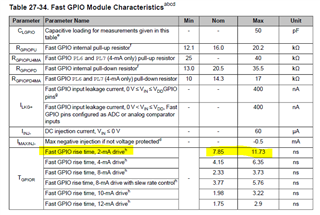Other Parts Discussed in Thread: ADS1278
We have a ADS1278 on the far side of an isolation barrier using IL715 digital isolators. The isolators introduce about 10ns of delay to signals crossing the barrier so in our existing design using a Blackfin processor we send the serial clock across the barrier to the ADC then bring it back along with the serial data line to the processor so that the delay crossing the barrier is the same for the clock and the data. Due to supply issues we need to replace the Blackfin. We have a related system using a TM4C1294KCPDT and hoped to use a design based on that the replace the Blackfin based backend.
The "17.3.5 High Speed Clock Operation" mode looks like it would allow the Tiva in master mode to accept a skewed clock which would allow the Tiva to work with the isolated ADC. However I can't see how to actually use that mode in practice. Surely that would require a master clock output generated by the Tiva and a receive clock input, but there don't seem to be any pins matching those role.
What does the High Speed Clock Operation mode actually do and how do we use it?



